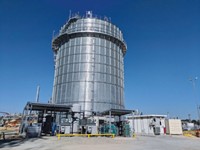Advertisement
Grab your lab coat. Let's get started
Welcome!
Welcome!
Create an account below to get 6 C&EN articles per month, receive newsletters and more - all free.
It seems this is your first time logging in online. Please enter the following information to continue.
As an ACS member you automatically get access to this site. All we need is few more details to create your reading experience.
Not you? Sign in with a different account.
Not you? Sign in with a different account.
ERROR 1
ERROR 1
ERROR 2
ERROR 2
ERROR 2
ERROR 2
ERROR 2
Password and Confirm password must match.
If you have an ACS member number, please enter it here so we can link this account to your membership. (optional)
ERROR 2
ACS values your privacy. By submitting your information, you are gaining access to C&EN and subscribing to our weekly newsletter. We use the information you provide to make your reading experience better, and we will never sell your data to third party members.
Green Chemistry
Investors chase sustainable aromatics
Processes using lignin, sugar, plastic waste, and more are moving out of the lab
by Alex Scott
February 19, 2020
| A version of this story appeared in
Volume 98, Issue 8

Ludo Diels, a research leader at the Belgian science institute Vito, gives a hopeful smile when asked if aromatic molecules—which make up about 40% of all industrial chemicals produced today—could soon be made from waste biomaterials or plastic.
Several years ago there was widespread talk that the arrival of such sustainable aromatics was imminent, but little—if any—commercial activity materialized. This time, though, Diels, who chairs the advisory board of Shared Research Center Biorizon, a Dutch research center that is striving to commercialize bioaromatics, is confident bioaromatics will soon be developed. “It’s our ambition to be on the market in 2025, and we are on schedule,” Diels says.
A key difference between now and even a couple of years ago is that several processes have left the lab and are being tested in pilot plants. This is especially so in Europe, where technology companies are inviting would-be customers to try out kilogram quantities of product. Conversations now are about the amount of money companies are seeking—or have already secured—to build demonstration plants. Some companies outside Europe, including US-based Anellotech, are also advancing plans to bring bioaromatics to market.
Biorizon, the Europe-centric consortium that Diels cofounded in 2013, is at the heart of Europe’s bioaromatics effort. It has received more than $50 million from European governments and the European Commission for technology development. Big companies, including Huntsman, Neste, Sabic, Covestro, and DSM, are among its members, which have multiplied from 25 in its inaugural year to more than 300 today.
Biorizon members are getting aromatics from raw materials including sugar, mixed plastic waste, and lignin, a low-value by-product of the pulp and paper industry. Target aromatic molecules are the building-block chemicals benzene, toluene, and xylene as well as more specialized aromatics.
Having large volumes of low-cost feedstock is one thing, but converting them into aromatic compounds has proved challenging. Thermochemical and catalytic processes are generally at earlier stages of development. More advanced are pyrolysis or gasification processes. “Some are already nearly precommercial,” Diels says.
Lignin has proved to be a particularly challenging feedstock. “As the saying goes, you can make anything from lignin except money,” Diels says. Current technologies for processing lignin fail to retain the functionality of aromatic rings within the material, and often lignin is used simply as a fuel. But Diels is convinced that Biorizon members are on the way to solving this conundrum.
One solution is to carefully depolymerize lignin and separate out monomers, says Jean Behaghel de Bueren, chief scientific officer at Bloom Biorenewables, a start-up based in Lausanne, Switzerland. Bloom’s approach is to treat wood with an aldehyde that both separates lignin from wood’s two other main components—cellulose and hemicellulose—and stabilizes it, preserving its ether bonds so that it can be used to make bioaromatics, Behaghel de Bueren says.
“We are currently the only ones able to extract a native, soluble form of this lignin that can be valorized or converted into platform molecules with near-theoretical rates,” Bloom CEO and cofounder Remy Buser says in a recent company video. “That means we extract everything that can be extracted.”
The company is currently making batches of about 1 kg of bioaromatics and looking to scale up its process. To date, Bloom has raised more than $1.7 million from investors. It is seeking $4 million to build a pilot facility and, later, $60 million for a demonstration-scale facility.
While Bloom has yet to hit its funding target, investors appear to be warming to the concept of bioaromatics. A consortium of 15 companies involved in a Biorizon lignin project has raised about 90% of the $55 million it needs to build a demonstration plant, possibly in Antwerp, Belgium. The money has been put up by an unnamed venture capital firm.
Although it is clear that bioaromatics will cost more than their petrochemical equivalents, would-be purchasers are lining up to test them. “Companies on the application side are waiting on the suppliers for samples,” says Willem Sederel, an industry veteran and board member for Biobased Delta, an alliance of Dutch provinces and businesses focused on the bioeconomy.

The Dutch national research institute TNO is one of the organizations sharing its samples. At Biorizon’s annual conference in Antwerp last November, TNO unveiled nine bioaromatic compounds derived from furfuran via sugar feedstock, that it can produce in kilogram-scale batches. The organization recently created a spin-off company named Relement to commercialize its bioaromatics technologies, says TNO business development manager Roger Blokland.
While TNO is at the sample production phase, the Dutch start-up BioBTX, whose CEO Pieter Imhof formerly worked for AkzoNobel and Avantium, is raising money to build a commercial plant to obtain aromatics from waste plastic. The firm secured an undisclosed amount of series B funding in December 2019 from five private and public organizations, including the Dutch venture capital firm Carduso Capital. Slated for start-up in 2023, the plant will be located in the Netherlands’ north, the company says.
In BioBTX’s process, raw material is decomposed and vaporized with pyrolysis and, in a second step, catalytically converted to aromatics. The steps are kept separate, the firm says, to avoid poisoning the catalyst with contaminants in the raw material.
“We convert vapors coming out of pyrolysis, and we can steer them directly to aromatics,” Imhof says. The firm’s pilot facility in Groningen, the Netherlands, has been running since September 2018 and has delivered yields above 40% in ideal conditions. “Today we are looking for partners to accelerate commercialization and to get feedstock availability,” Imhof says.
As its name implies, BioBTX intends to produce benzene, toluene, and xylenes as drop-in replacements for the petrochemical versions. The specialty chemical maker Huntsman is taking a different approach with what Arend Jan Zeeuw, global process development manager for polyurethanes, hopes will be a fast and “capital light” route to bioaromatics that avoids the costly step of purifying raw materials.
Huntsman is collaborating with undisclosed partners in the pulp and paper and refining industries to take black liquor, a waste stream from the pulp and paper industry, and use it as a secondary feedstock along with petroleum to create benzene and other aromatics that are partly biobased.
Huntsman would like to use benzene derived this way to make isocyanates, a precursor for polyurethanes, Zeeuw says. Such volumes could potentially take up the entire black liquor waste stream of a pulp mill, he notes.
“The driver is as much about price stability as sustainability. It is a major opportunity. Annually, there is more than 140 million t of black liquor globally,” Zeeuw says. “With testing at demonstration scale in the next couple of years to get confidence in catalyst life, realistically it will be 5 years from now before such a process is at commercial scale.”
If the process is successful, Huntsman could stabilize prices, diversify raw materials, and reduce greenhouse gas emissions by getting conventional petrochemicals partly from biomaterials. At the same time, Huntsman is one of a number of companies investigating how unique bioaromatics could bring novel functionality to their products.
Luc Peeters, R&D manager for the Japanese specialty chemical firm Kaneka, says tests undertaken with Vito, the Belgian science institute, show that construction sealants derived from lignin offer improved temperature stability and ultraviolet-light stability compared with petrochemically derived products.
“This is good for automotive applications or roofing, where temperatures can exceed 70 °C,” Peeters says. Kaneka is building a pilot facility to make the biobased sealants.
The Dutch firm Avantium is likewise counting on the unique properties of a bioaromatic-based polymer it is developing, polyethylene furanoate (PEF), to help it steal business away from polyethylene terephthalate, the chief polymer used to produce bottles and other food containers.
The challenge for many bioaromatic molecules is that they are no different from the petrochemical standards, says Avantium’s CEO, Tom van Aken. PEF, in contrast, brings something new. “It has superior gas-barrier properties compared with polyethylene terephthalate and so can carve out an advantage for certain applications,” he says.
As a burgeoning number of European companies work on renewable aromatics, the US landscape looks empty in comparison. One player is Anellotech, a 10-year-old start-up that has been operating a pilot facility in Texas since January 2017. The firm has developed a thermal catalytic process for converting loblolly pine biomass into aromatics. The process is generating yields of 22–24%, CEO David Sudolsky says.
Anellotech is also adapting its process to use mixed plastic waste. “We can go direct from plastics to aromatics and olefins and have shown in early lab experiments that we can shift the product slates to strongly favor either one,” Sudolsky says. Anellotech had raised $15 million for the Texas pilot plant studies.
The company is backed by a small number of strategic partners, including Johnson Matthey—a catalyst provider for the firm—and the Japanese beverage firm Suntory. “We are raising funds for the first commercial plant right now, with interest coming from companies needing to be first with biosources of benzene, toluene, and xylene for bio-PET, bionylon, biopolycarbonate, biostyrenics, and more,” Sudolsky says.
Investor and manufacturer interest around bioaromatics is building. Driven by consumer sentiment and regulations promoting sustainable plastics production, this nascent sector is emerging. As Vito’s Diels says of activities at Biorizon, “This is not fundamental research or trial and error anymore.”
CORRECTION
This story was updated on March 2, 2020, to correct the amount Bloom Biorenewables has raised from outside investors. It has raised more than $1.7 million, not $66,000.
This story was updated on Feb. 27, 2020, to note that Arend Jan Zeeuw's last name is Zeeuw, not Jan Zeeuw, and to clarify the partners that Zeeuw's company, Huntsman, are working with to use black liquor from the paper industry to make aromatic compounds. In addition, the figure for global black liquor production was refined to note that there is more than 140 million t of black liquor globally, and figures for Huntsman’s desired use of biobased benzene were removed, as Zeeuw says the firm has no specific targets.




Join the conversation
Contact the reporter
Submit a Letter to the Editor for publication
Engage with us on Twitter